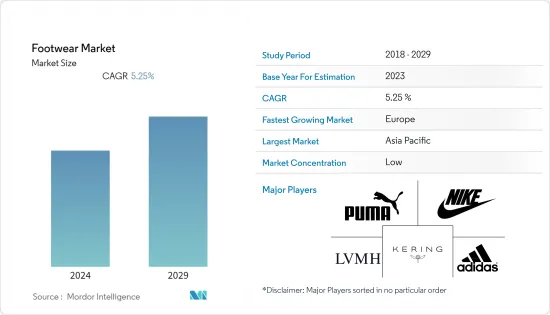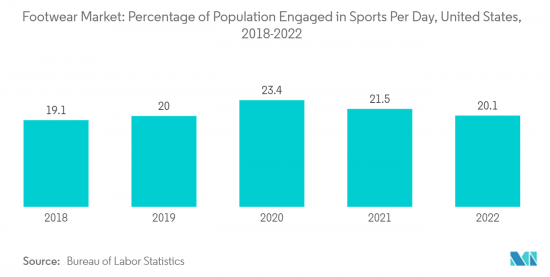 |
市場調査レポート
商品コード
1406046
フットウェア:市場シェア分析、産業動向・統計、成長予測、2024年~2029年Footwear - Market Share Analysis, Industry Trends & Statistics, Growth Forecasts 2024 - 2029 |
||||||
● お客様のご希望に応じて、既存データの加工や未掲載情報(例:国別セグメント)の追加などの対応が可能です。 詳細はお問い合わせください。
| フットウェア:市場シェア分析、産業動向・統計、成長予測、2024年~2029年 |
|
出版日: 2024年01月04日
発行: Mordor Intelligence
ページ情報: 英文 140 Pages
納期: 2~3営業日
|
- 全表示
- 概要
- 目次
フットウェア市場規模は、2024年の4,105億8,000万米ドルから2029年には5,302億8,000万米ドルに成長し、予測期間中(2024-2029年)のCAGRは5.25%の成長が見込まれています。

主なハイライト
- ファッショナブルでトレンディー、しかも履き心地の良いフットウェアへの需要があらゆる年齢層で高まっていることが、世界のフットウェア産業を牽引する重要な要因です。サッカー、クリケット、バスケットボール、ゴルフなど、スポーツに特化したフットウェアの増加が、スポーツリーグやスポーツ参加を促進するための政府や世界的組織による急激な投資と相まって、市場の主要促進要因となっています。
- 中国やインドなどのアジア諸国は、先進国全体の革製フットウェアの主要輸出国です。例えば、Department for Promotion of Industry and Internal Tradeによると、2022年にはインドから世界の他の地域に約20億4,708万米ドル相当の革製フットウェアが輸出されたと推定されています。
- さらに、世界のフットウェア市場における新たな動向として、環境に優しいフットウェアに対する需要の高まりがあります。持続可能な材料の使用や、創業当初から持続可能性をブランドに組み込んできた持続可能なフットウェアブランドが増加しています。メーカー各社は、顧客の需要に合うような製品を製造する革新的な方法を見出しています。
- 例えば、2022年8月、インド土着のサステナブルフットウェア企業であるソールクラフトは、初の耐汗性チャコールシューズの発売を発表しました。同社は、この環境に優しいスニーカーの製造には天然材料のみを使用したと主張しています。同社は、この製品がインドで開発され、日本の竹炭、オーストラリアの高級メリノウール、植物由来のリサイクルコーヒーかすオイルを使用して製造されたことを明らかにしました。
- アスレジャーは、ミレニアル世代の親たちのフットウェア選びに影響を与え、より浸透してきました。そのため、ミレニアル世代の親たちは子供たちにアスレチックウェアやフットウェアを着せています。これが世界中のフットウェア全体の売上を牽引しています。
- ブーツ、サンダル、ビーチサンダルなどの非アスレジャー用フットウェア製品は、消費者が日常生活でよく使うものです。そのため、市場のメーカーは消費者を惹きつけるために、革新的で使い勝手の良いデザインに力を入れています。さらに、スニーカーは、履き心地とデザイン性の高さから、市場全体で人気の高い製品タイプのひとつとなっています。スニーカーは若い消費者に人気があります。彼らは投資として高価なスニーカーを購入する傾向があり、市場で入手可能な高級コレクションに熱中しています。
フットウェア市場の動向
アスレチックフットウェアセグメントの需要増加の可能性
- スポーツやフィットネス活動による健康効果に対する熱意と意識の高まり、世界のeコマースセクターの隆盛、消費者の可処分所得の増加が、このセグメントの成長を促進する主な要因です。座りっぱなしのライフスタイルによる健康不安の高まりと、それに起因する問題が、アスレチックフットウェアの需要に恩恵をもたらしています。このため、人々は屋内外での身体活動に積極的に参加するようになっています。
- サッカー、バスケットボール、テニス、バドミントンなどのスポーツや、ランニング、ジムなどのその他の活動は、消費者の間で一般的になっています。このような要因により、顧客はそのスポーツ専用のシューズを複数購入したり所有したりするようになり、その結果、市場でのシューズの売上が増加します。
- さらに、オリンピック、コモンウェルスゲームズ、アジアゲームズ、クリケット・ワールドカップ、スーパーボウル、FIFAワールドカップなど、定期的に開催される主要な世界的スポーツイベントも、アスリートとそうでない個人の両方からの需要を押し上げています。フットウェア市場は、健康志向の高まりから、ライフスタイルユーザーによるアスレチックフットウェアの需要が急増しています。

アジア太平洋地域がフットウェア産業で顕著なシェアを占める
- 中国とインドだけで世界人口の3分の1近くを占めているため、アジア太平洋は世界最大のフットウェア市場です。アジア太平洋諸国は、今後もそのリードを維持していくと思われます。これらの国々は、世界のフットウェア市場全体のほぼ40%を占めています。この背景には、急速な都市化や、特に中流階級や富裕層が欧米のライフスタイルやブランドを好むといったいくつかの要因があります。また、この地域には多くの多国籍スポーツ用品企業があり、イノベーションの最前線に立つことが多いです。これらの企業は、デザインへの嗜好と優れた品質への嗜好の両方を満たす新しいフットウェアの開発で世界をリードすると思われます。
- Thailand Textile Instituteによると、2022年には約21億6,000万米ドル相当のレザーウェアとフットウェア製品がタイに輸入されました。タイのレザーウェアとフットウェアの輸入額は前年に比べ増加しました。World Footwearによると、2022年の世界のフットウェア生産はアジアだけで約87.4%を占め、この地域がフットウェア製造業に大きく集中していることを反映しています。これは、安価な労働力と原材料が入手可能なため、メーカーがフットウェアを低価格で大量生産できるようになったためです。このため、競争力のある価格でフットウェアカテゴリーに数多くの選択肢が用意されるようになり、この地域全体で調査された市場の原動力となっています。
- さらに、アジア太平洋地域のフットウェア産業は、人々の健康に対する意識と意識、そして現在進行中のファッション動向を背景に、近年牽引力を増しています。このため、手頃な価格帯を武器に、主に小規模な都市や町を中心に、多くの消費者を取り込もうとする新規参入者が続出しています。これらのブランドは、Amazon、Flipkart、楽天、Foot Locker、Myntraなどのオンライン小売業者を支援し、アジア太平洋市場に参入しています。
フットウェア業界の概要
世界のフットウェア市場は競争が激しく、Puma SE、Nike Inc.、Adidas AG、LVHM、Keringa SA、Puma SEなどの有力企業が主要市場シェアを占めています。これは、ブランド、製品、パートナーシップ、広告を通じて業界を強力に掌握していることを反映し、市場浸透率が高いことに起因しています。これらの先進的なブランドは、フットウェア市場の需要に応えるため、積極的なデジタルキャンペーンの採用、持続可能なフットウェアを含む革新的でカスタマイズ可能な幅広い製品の提供、子供用に特別にデザインされたアスレチックフットウェアを含むあらゆる年齢層の嗜好に応えるユニークで性別にとらわれないデザイン、ブランドとのコラボレーションなど、ありとあらゆる戦略を駆使しています。
その他の特典:
- エクセル形式の市場予測(ME)シート
- 3ヶ月間のアナリストサポート
目次
第1章 イントロダクション
- 調査の前提条件と市場定義
- 調査範囲
第2章 調査手法
第3章 エグゼクティブサマリー
第4章 市場力学
- 市場促進要因
- アスレジャー用フットウェア需要の急増
- ブランドによる積極的なマーケティング
- 市場抑制要因
- 偽造品の氾濫
- ポーターのファイブフォース分析
- 新規参入業者の脅威
- 買い手/消費者の交渉力
- 供給企業の交渉力
- 代替品の脅威
- 競争企業間の敵対関係の強さ
第5章 市場セグメンテーション
- タイプ
- アスレチックフットウェア
- ランニングシューズ
- スポーツシューズ
- トレッキングシューズ
- その他
- 非アスレチックフットウェア
- ブーツ
- ビーチサンダル
- スニーカー
- その他
- アスレチックフットウェア
- エンドユーザー
- 男性
- 女性
- 子供
- 流通チャネル
- オフライン小売店
- オンライン小売店
- 地域
- 北米
- 米国
- カナダ
- メキシコ
- その他北米地域
- 欧州
- ドイツ
- 英国
- フランス
- ロシア
- スペイン
- イタリア
- その他欧州
- アジア太平洋
- 中国
- 日本
- インド
- オーストラリア
- その他アジア太平洋地域
- 南米
- ブラジル
- コロンビア
- その他南米
- 中東・アフリカ
- 南アフリカ
- サウジアラビア
- その他中東・アフリカ
- 北米
第6章 競合情勢
- 主要企業の戦略
- 市場シェア分析
- 企業プロファイル
- Nike Inc.
- Adidas AG
- New Balance Athletics, Inc.
- Asics Corporation.
- LVMH Moet Hennessy Louis Vuitton SE
- Fila Holdings Corp.
- The Bata Corporation
- VF Corporation
- Puma SE
- Under Armour
- Kering SA
第7章 市場機会と今後の動向

The footwear market size is expected to grow from USD 410.58 billion in 2024 to USD 530.28 billion by 2029, at a CAGR of 5.25% during the forecast period (2024-2029).
Key Highlights
- The rising demand for fashionable, trendy, yet comfortable footwear across all age groups is a key factor driving the global footwear industry. The rise in the growth of sports-focused footwear, such as football, cricket, basketball, and golf, coupled with exponential investment by governments and global organizations to promote sports leagues and participation, has been a key driver for the market.
- Asian countries, such as China and India, are the major exporters of leather footwear across developed countries. For instance, according to the Department for Promotion of Industry and Internal Trade, it is estimated that about USD 2,047.08 million worth of leather footwear products was exported from India to other parts of the world in 2022.
- Additionally, an emerging trend in the global footwear market is the rise in demand for eco-friendly footwear. There has been a growth in the usage of sustainable materials and sustainable footwear brands that have embedded sustainability into their brands from their beginnings. The manufacturers have been finding innovative ways to manufacture such products to suit customer demands.
- For instance, in August 2022, Solecraft, an indigenous sustainable footwear company in India, announced the launch of its first pair of sweat-resistant charcoal shoes. The company claimed that only natural materials were used in the manufacturing of these eco-friendly sneakers. The company revealed that the product was developed in India and manufactured using Japanese bamboo charcoal, premium Australian Merino wool, and plant-based recycled coffee grounds oil.
- Athleisure has become more pervasive, as it has influenced the athletic footwear choice among millennial parents. Due to this factor, they are dressing their kids in athletic apparel and footwear. This is driving the sales of overall footwear across the world.
- Non-athleisure footwear products such as boots, sandals, and flip-flops are commonly used by the consumer in day-to-day life. Hence, manufacturers in the market are focusing on innovative and user-friendly designs to attract consumers. Moreover, sneakers stand out to be one of the popular types of footwear products across the market owing to the comfort and design of the products. Sneakers were popular among young consumers. They often tend to buy expensive pairs of sneakers as an investment and enthusiasm towards exclusive collections available across the market.
Footwear Market Trends
Potential Increase in Demand for the Athletic Footwear Segment
- Growing enthusiasm and awareness regarding the health benefits of sports and fitness activities, the flourishing retail e-commerce sector worldwide, and rising levels of disposable income of consumers are the key factors facilitating segment growth. Rising health concerns because of a sedentary lifestyle and the resultant problems caused by it are benefitting athletic footwear demand. This influences people to actively take part in both indoor and outdoor physical activities.
- Sports such as soccer, basketball, tennis, badminton, and other physical activities such as running, gymming, and others have become common among consumers. For instance, according to Sports England, it is estimated that about 5,896.8 participated in running, 4,842.6 in gym sessions, and 2,012.3 participated in soccer and other physical activities at least twice a month in England between 2021 and 2022. These sports require a certain amount of physical fitness and minimum equipment, such as shoes that protect feet and give comfort while performing the activity. These factors encourage the customer to buy or own more than one pair of footwear dedicated to the sport, resulting in increasing the sales of the footwear in the market.
- Moreover, major global sporting events held periodically, like the Olympics, Commonwealth Games, Asian Games, Cricket World Cup, Super Bowl, and FIFA World Cup, also boost the demand from both athletes and non-athletes individuals. For example, in March 2022, Puma partnered with Lega Serie A. Puma to be a technical partner of the football league and was the official supplier of athleisure and football for all matches in Europe. The footwear market has seen a steep rise in the demand for athletic footwear emerging from lifestyle users, owing to the growing health consciousness.

Asia-Pacific Holds a Prominent Share in Footwear Industry
- China and India alone account for nearly one-third of the global population, and this ensures that the Asia-Pacific is the largest footwear market in the world. Countries are likely to maintain their lead as combined. They comprise almost 40% of the entire global footwear market. This can be attributed to several factors, like rapid urbanization and a preference to adopt a Western lifestyle and/or brands, especially in the middle class and rich society. The region is also home to many multinational sports equipment companies that are often at the forefront of innovation. They will likely lead the world in developing new footwear that fulfills both the penchant for design and a preference for superior quality.
- According to the Thailand Textile Institute, around USD 2.16 billion worth of leatherwear and footwear products were imported into Thailand in 2022. Thailand's imports of leather clothing and footwear grew in value that year compared to the year before. According to World Footwear, Asia alone accounted for approximately 87.4% of the world's footwear production in 2022, reflecting the region's significant concentration of the footwear manufacturing industry. This was due to the availability of cheap labor and raw materials, which allowed the manufacturers to produce the footwear at lower prices in bulk amounts. This has led to the availability of numerous options in the footwear category at competitive prices, which drives the market studied across the region.
- Moreover, the footwear industry in Asia-Pacific has been gaining traction in recent years, given people's awareness and consciousness about health and ongoing fashion trends. This has led to a slew of new players, most of whom bank on affordable price points to dive into the masses, mostly in smaller cities and towns. These brands buttress online retailers like Amazon, Flipkart, Rakuten, Foot Locker, and Myntra to penetrate the Asia-Pacific market.
Footwear Industry Overview
The global athletic footwear market is highly competitive, with major market share held by prominent players, such as Puma SE, Nike Inc., Adidas AG, LVHM, Keringa SA, and Puma SE. This is attributable to its higher market penetration, reflecting a strong industry grip through its brands, products, partnerships, and advertising. These progressive brands have laid their hand on every possible strategy to cater to the footwear market's demand, which includes employing aggressive digital campaigns, offering a wide range of innovative and customizable products, including sustainable footwear, unique and gender-neutral designs that cater to the preferences of all age groups, including athletic shoes specifically designed for kids, and brand collaborations.
Additional Benefits:
- The market estimate (ME) sheet in Excel format
- 3 months of analyst support
TABLE OF CONTENTS
1 INTRODUCTION
- 1.1 Study Assumptions and Market Definition
- 1.2 Scope of the Study
2 RESEARCH METHODOLOGY
3 EXECUTIVE SUMMARY
4 MARKET DYNAMICS
- 4.1 Market Drivers
- 4.1.1 Surging Demand for Athleisure Footwear
- 4.1.2 Aggressive Marketing by Brands
- 4.2 Market Restraints
- 4.2.1 Extensive Availability of Counterfeit Products
- 4.3 Porter's Five Forces Analysis
- 4.3.1 Threat of New Entrants
- 4.3.2 Bargaining Power of Buyers/Consumers
- 4.3.3 Bargaining Power of Suppliers
- 4.3.4 Threat of Substitute Products
- 4.3.5 Intensity of Competitive Rivalry
5 MARKET SEGMENTATION
- 5.1 Type
- 5.1.1 Athletic Footwear
- 5.1.1.1 Running Shoes
- 5.1.1.2 Sports Shoes
- 5.1.1.3 Trekking/Hiking Shoes
- 5.1.1.4 Other Athletic Footwear Types
- 5.1.2 Non-athletic Footwear
- 5.1.2.1 Boots
- 5.1.2.2 Flip-Flops/Slippers
- 5.1.2.3 Sneakers
- 5.1.2.4 Other Non-athletic Footwear
- 5.1.1 Athletic Footwear
- 5.2 End-User
- 5.2.1 Men
- 5.2.2 Women
- 5.2.3 Kids
- 5.3 Distribution Channel
- 5.3.1 Offline Retail Stores
- 5.3.2 Online Retail Stores
- 5.4 Geography
- 5.4.1 North America
- 5.4.1.1 United States
- 5.4.1.2 Canada
- 5.4.1.3 Mexico
- 5.4.1.4 Rest of North America
- 5.4.2 Europe
- 5.4.2.1 Germany
- 5.4.2.2 United Kingdom
- 5.4.2.3 France
- 5.4.2.4 Russia
- 5.4.2.5 Spain
- 5.4.2.6 Italy
- 5.4.2.7 Rest of Europe
- 5.4.3 Asia-Pacific
- 5.4.3.1 China
- 5.4.3.2 Japan
- 5.4.3.3 India
- 5.4.3.4 Australia
- 5.4.3.5 Rest of Asia-Pacific
- 5.4.4 South America
- 5.4.4.1 Brazil
- 5.4.4.2 Colombia
- 5.4.4.3 Rest of South America
- 5.4.5 Middle East & Africa
- 5.4.5.1 South Africa
- 5.4.5.2 Saudi Arabia
- 5.4.5.3 Rest of Middle East & Africa
- 5.4.1 North America
6 COMPETITIVE LANDSCAPE
- 6.1 Strategies Adopted by Leading Players
- 6.2 Market Share Analysis
- 6.3 Company Profiles
- 6.3.1 Nike Inc.
- 6.3.2 Adidas AG
- 6.3.3 New Balance Athletics, Inc.
- 6.3.4 Asics Corporation.
- 6.3.5 LVMH Moet Hennessy Louis Vuitton SE
- 6.3.6 Fila Holdings Corp.
- 6.3.7 The Bata Corporation
- 6.3.8 VF Corporation
- 6.3.9 Puma SE
- 6.3.10 Under Armour
- 6.3.11 Kering SA
